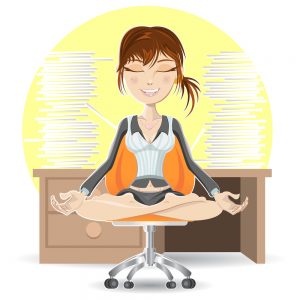In the fast-paced, high-pressure environments that characterize today’s corporate landscape, workplace meditation emerges as a vital tool to enhance corporate productivity and well-being. This practice, deeply rooted in mindfulness and stress management techniques, offers a multitude of benefits ranging from improved mental health to enhanced focus and creativity. Incorporating meditation into the workplace is not just a trend but an actionable strategy to combat workplace stress, foster a culture of wellness, and ultimately, contribute to the overall success of an organization. Meditation Instructors through AIHCP’s certification program can better assist corporation and businesses with the training in meditation to help their employees.

This article will delve into the importance of workplace meditation and explore how mindfulness and meditation techniques can significantly improve productivity and mental health among employees. Further, it will examine various case studies of successful implementations, elucidate the different types of workplace meditation programs, and provide insights into creating a meditation-friendly environment. Challenges in integrating meditation into corporate routines will be addressed, along with strategies to overcome such obstacles. Best practices for implementing meditation programs will also be discussed to guide organizations in embracing mindfulness training. By providing a comprehensive overview, this piece aims to underscore the tangible benefits of meditation in the workplace, paving the way for more mindful, productive, and healthy work environments.
Key Takeaways
- Meditation programs in corporations help reduce stress and improve well-being.
- Implementing meditation in the workplace can increase productivity and employee participation.
- Corporate meditation classes benefit both companies and employees by promoting work-life balance.
- Engagement strategies with meditation and breathwork training lead to reduced stress and increased focus.
- Corporate meditation training courses empower employees with stress management skills and enhance resiliency.
The Importance of Workplace Meditation
In contemporary corporate settings, the significance of workplace meditation is increasingly recognized as a crucial element for enhancing employee performance and organizational health. This practice not only aids individuals in managing stress but also fosters an environment conducive to productivity and creativity.
As an employer, you have the opportunity to support your employees in reducing stress and enhancing their well-being through corporate meditation programs. These programs are designed to introduce meditation practices in the workplace, promoting mindfulness and stress reduction among employees. Corporate meditation is an inclusive benefit that can positively impact individuals from various backgrounds and cultures. By offering meditation programs at work, you are prioritizing the wellness of your diverse workforce. Meditation, a well-known method for stress relief, is cost-effective and simple to implement, making it highly effective in corporate environments. Implementing a corporate meditation program can provide employees with the tools and support needed to establish a consistent meditation practice, leading to long-term benefits both at work and in their personal lives.
Benefits for Employees
Workplace meditation offers profound benefits for employees, impacting their mental and physical health, which in turn enhances their work performance. Studies, such as those conducted by Harvard Medical School, indicate that meditation contributes to changes in brain regions related to learning and working memory capacity. This improvement in cognitive functions is crucial for sustaining attention and minimizing both external and internal distractions.
Moreover, mindfulness practices are linked to enhanced problem-solving and creative thinking. Research from the University of Groningen supports the notion that regular mindfulness meditation encourages divergent thinking, a key element in creativity. Employees who engage in regular meditation sessions report increased ability to generate innovative solutions and exhibit reduced cognitive rigidity.
The emotional and psychological benefits are equally significant. Regular mindfulness practice can lead to notable improvements in mood, reducing symptoms of severe depression and anxiety, as evidenced by studies from institutions like Boston University. These changes contribute to a more positive workplace atmosphere, as employees bring a heightened sense of patience and positivity to their roles.
Benefits for the Organization
From an organizational perspective, the integration of meditation practices into the corporate culture yields substantial rewards. Enhanced focus and reduced stress levels lead to greater overall productivity. For instance, mindfulness programs have been shown to dramatically decrease employee absenteeism and tardiness, as employees start their day with a positive outlook and maintain higher energy levels throughout the workday.
Furthermore, the practice of meditation has been found to significantly reduce employee turnover and burnout, fostering a more stable and committed workforce. Managers who participate in meditation programs often report improved leadership abilities, treating team members with greater empathy and creating a more inclusive and supportive work environment.
Organizational benefits also extend to enhanced problem-solving capabilities. Employees skilled in meditation are better equipped to handle challenging situations, viewing problems through multiple lenses and identifying innovative solutions. This ability is crucial in maintaining a competitive edge in today’s fast-paced business world.
In conclusion, the implementation of workplace meditation programs not only benefits individual employees by improving their mental health and cognitive abilities but also enhances organizational effectiveness. By fostering a healthier, more creative, and cohesive workforce, companies can achieve higher productivity and improved workplace dynamics.
How Meditation Improves Productivity
Meditation has been recognized as a powerful tool to enhance focus and concentration in the workplace. This practice trains the mind to manage the continuous noise and distractions of the external world, akin to a computer reboot that refreshes the central processing unit. By clearing the backlog of thoughts, meditation improves the mind’s efficiency and speed, allowing employees to focus more effectively on their tasks.

Enhancing Focus and Concentration
The process of meditation involves focusing on a single point, such as the breath or a specific thought, which trains the brain to direct and sustain focus on chosen points. This practice is supported by research indicating that meditation increases the working memory capacity by improving top-down attention control. For instance, a study comparing a group of novice meditators to a control group found that those who engaged in focused attention meditation significantly enhanced their ability to concentrate and manage distractions.
Additionally, mindfulness meditation, which emphasizes being present and aware, helps individuals let go of extraneous thoughts. Techniques like counting breath cycles or engaging in Zen meditation strengthen the mind’s stability and focus. These methods have been shown to lead to greater mental stability and an increased ability to focus, as frequent meditators demonstrate superior focus and are less susceptible to distractions.
Reducing Absenteeism
The benefits of meditation extend beyond mental focus to influence physical presence in the workplace. Meditation practices reduce stress and anxiety, which are significant contributors to absenteeism. By lowering stress levels and improving overall emotional health, employees are more likely to maintain consistent attendance and exhibit punctuality. Mindfulness practices have been shown to decrease employee tardiness and absenteeism dramatically, as individuals begin their days with a positive outlook and maintain higher energy levels throughout the workday.
Moreover, meditation contributes to a reduction in employee turnover and burnout by fostering a more stable and committed workforce. Managers who incorporate meditation into their routines often report improved leadership abilities and a more inclusive work environment, which in turn supports a stable employee base and reduces the frequency of stress-related absences.
In conclusion, integrating meditation into daily work routines not only sharpens focus and concentration but also significantly reduces absenteeism, thereby enhancing overall productivity and fostering a healthier, more engaged workforce.
Mental Health Benefits
Workplace meditation significantly contributes to mental health improvements, offering a robust solution for reducing stress and enhancing emotional regulation among employees. The integration of mindfulness and meditation into daily work routines has been supported by numerous studies, demonstrating substantial benefits in both personal well-being and workplace harmony.
Reducing Stress and Anxiety
Research consistently highlights the efficacy of meditation in mitigating stress and anxiety levels within corporate environments. Stanford University School of Medicine reports a 30% decrease in stress-related symptoms following meditation practices. Similarly, the Wellness Institute in Cleveland found a significant reduction in stress levels among employees at a corporate call center after participating in an eight-week mindfulness program. These programs not only reduce immediate stress but also decrease the risk of stress-related illnesses, enhancing overall employee health and workplace productivity.
Moreover, meditation’s impact on stress reduction is also evident in reduced absenteeism and lower turnover rates. Companies implementing regular meditation sessions have observed a decline in employee burnout and improved mental resilience, making it a valuable tool for managing workplace stress.
AIHCP also offers a Stress Management Certification for qualified professionals who look to not only teach meditation but also offer stress management skills to corporations and businesses.
Improving Emotional Regulation
Meditation also plays a crucial role in improving emotional regulation, which is vital for maintaining a harmonious and productive work environment. Studies indicate that meditation can enhance the brain’s ability to control negative emotions and recover quickly from emotional disturbances. This is particularly beneficial in high-pressure situations where emotional reactivity can compromise decision-making and interpersonal relationships.
The practice of mindfulness meditation fosters greater present-moment awareness, which allows employees to respond to stress with more adaptive strategies. This heightened awareness also reduces the activation of the amygdala, the brain region associated with emotional processing, which is often triggered during stress. By cultivating a mindful approach to workplace challenges, employees can maintain a calm and focused demeanor, contributing positively to their interactions and overall workplace atmosphere.
In conclusion, the mental health benefits of workplace meditation are profound, offering significant advantages in reducing stress and improving emotional regulation. These benefits not only enhance individual well-being but also contribute to a more supportive and productive organizational culture.
Case Studies of Successful Implementations
Corporate meditation classes and mindfulness training have become popular in many leading companies like Apple, Google, Yahoo, and Nike. These programs aim to reduce stress, enhance focus, and increase productivity among employees. Different structures for these classes include a certified meditation facilitator leading group sessions, customized packages by corporate mindfulness specialists, and workshops on stress management and mindful leadership. Certified Meditation Instructors can play a role in implementing meditation training and stress management into a variety of companies. Many companies below utilize meditation for employees to increase production.
At Google, the initiative known as “Search Inside Yourself” was developed by Meng, an early engineer at the company. This program was grounded in the scientific study of mindfulness and meditation, appealing to the data-driven culture of Google. The program aimed to enhance positive emotions, resilience, prosocial behavior, and mindfulness among employees. By focusing on these aspects, Google has fostered a work environment where employees exhibit increased productivity and well-being. Additionally, the peer-led group gPause supports the ongoing practice of mindfulness, offering weekly or bi-weekly sessions that reinforce the principles taught in the Search Inside Yourself program.
SAP
SAP has integrated mindfulness into the core of its corporate life, offering two-day mindfulness courses to over 6,000 employees. These courses focus on meditations that are complemented by practices of self-mastery and compassion. SAP also provides internal mindfulness trainers who lead guided meditations during working hours, along with a multi-week mindfulness challenge that includes “micropractices” such as brief meditation sessions during the workday. This comprehensive approach has helped SAP create a more mindful, productive, and emotionally intelligent workforce.
General Mills
General Mills has adopted mindfulness programs that significantly impact employee productivity and corporate culture. The company’s mindfulness initiatives include leadership training, meditation training, and mindfulness micropractices. General Mills’ approach to mindfulness in the workplace aims to reduce stress, enhance leadership skills, and improve overall employee well-being. By integrating these practices, General Mills has seen a reduction in employee turnover and an improvement in workplace atmosphere, contributing to a more stable and committed workforce.
Types of Workplace Meditation Programs

In-person classes have traditionally been the cornerstone of workplace meditation programs. These sessions typically involve a trained facilitator leading groups through various meditation techniques, such as mindfulness-based stress reduction (MBSR). The benefits of in-person meditation classes include immediate feedback and the ability to tailor sessions to the specific needs of the group. Research has shown that these sessions not only improve mental health and resilience but also positively impact work productivity measures like absenteeism and presenteeism. However, the scalability of in-person classes can be limited by logistical challenges, such as the need for a dedicated space and scheduling that accommodates all employees.
Virtual sessions
With advancements in technology, virtual sessions have become a viable alternative to in-person classes. These sessions can be conducted live or recorded, providing flexibility in delivery. Live virtual sessions have been particularly effective in reducing stress, as they maintain a level of interaction and engagement through real-time communication. Participants can benefit from the convenience of joining from any location, which helps in overcoming barriers such as transportation and conflicting schedules. However, the effectiveness of recorded sessions in reducing stress is less clear, indicating the importance of interactive elements in virtual mindfulness training.
Meditation apps
The use of meditation apps in the workplace is an emerging trend that offers scalability and personalization. Apps like Headspace provide a library of meditation content that employees can access at their convenience. These apps are designed to help individuals manage stress, improve focus, and enhance overall mental well-being. Companies like Google and Genentech have incorporated meditation apps into their wellness programs, recognizing the value of providing tools that employees can use independently. Meditation apps allow for continuous practice and skill development, which is crucial for achieving the long-term benefits of mindfulness.
Each type of program offers unique advantages and can be integrated into a comprehensive workplace meditation strategy to meet the diverse needs of an organization’s workforce. By combining in-person classes, virtual sessions, and meditation apps, companies can create a flexible and inclusive meditation program that maximizes the benefits for both employees and the organization as a whole.
Creating a Meditation-Friendly Workplace
Creating a meditation-friendly workplace involves strategic design and active encouragement to foster a culture of mindfulness and relaxation among employees. This section outlines essential steps to establish dedicated meditation rooms and promote participation in mindfulness practices, which have been shown to enhance employee well-being and productivity.
Designated Meditation Rooms
To effectively support stress reduction and mental clarity, it is vital to establish designated meditation rooms within the workplace. These spaces should be designed to be free from distractions, providing a peaceful environment conducive to meditation and relaxation practices. Key elements to consider include:
- Soundproofing and Quiet: Ensuring the space is isolated from the noise and interruptions of the workplace is crucial. Soundproofing can be achieved through the use of specialized materials in walls and doors.
- Comfortable Furnishings: The room should be equipped with various furniture options such as mats for yoga, comfortable chairs for sitting, and cushions for relaxation. Providing the flexibility for different types of meditation and relaxation practices is essential.
- Natural Light and Outdoor Access: Whenever possible, incorporate natural lighting and provide access to outdoor spaces like gardens or walking paths which enhance the serenity of the meditation experience.
- Soothing Decor: Employ calming colors and minimalistic decor to create a tranquil atmosphere. Avoiding bold contrasts and stimulating patterns helps maintain the focus and calmness required for effective meditation.
Encouraging Participation
Merely providing meditation spaces is not enough; active encouragement and organization-wide support are necessary to ensure these facilities are utilized and beneficial.
Participation is key to boosting engagement in meditation and breathwork training. By offering guided meditation programs in the workplace, employees can experience reduced stress and improved concentration, leading to a more receptive attitude towards wellness initiatives. Employers who make meditation accessible are supporting their employees in practicing self-care and achieving a better work-life balance. This small investment can yield significant returns in terms of mental wellness, physical health, and overall productivity. Guided meditation combines relaxation techniques, mindfulness, and visualization to enhance mental clarity and well-being. It provides employees with a peaceful retreat within the busy work environment, promoting a calm and focused mindset for better performance. Investing in meditation and breathwork training is investing in a healthier, happier, and more productive team. Below are some keys.
- Internal Marketing and Education: Launch an internal marketing campaign to raise awareness about the available meditation spaces and their benefits. Educational seminars and workshops can help demystify meditation practices for employees, highlighting how these practices can improve both personal well-being and work performance.
- Incentives and Recognition: Implement incentive programs that reward regular participation in meditation sessions. Recognition can be given through small rewards or public acknowledgment in company communications.
- Flexible Scheduling: Encourage management to allow flexible scheduling so employees can make use of meditation rooms without feeling pressured by time constraints. Support from leadership is crucial in normalizing meditation breaks during the workday.
- Community Building: Organize regular group meditation sessions and encourage employees to share their experiences. This not only helps in building a community of practice but also supports new participants in establishing their meditation routines.
By integrating these elements into the workplace, organizations can create a supportive environment that promotes mental health and enhances overall productivity. A meditation-friendly workplace not only benefits individual employees by reducing stress and improving focus but also contributes to a more harmonious and efficient organizational culture.
Challenges and How to Overcome Them
Resistance to Change
One of the primary challenges organizations face when implementing mindfulness programs is resistance to change. Employees may feel uncomfortable with new practices that disrupt established routines or may fear the psychological uncertainty that comes with adapting to new ways of working. To address this, organizations can begin by clearly communicating the purpose and benefits of mindfulness, not just as a tool for individual well-being, but as a strategy for enhancing overall organizational health. Engaging employees through leadership training, meditation training, mindfulness micropractices, and mindfulness coaching can gradually shift cultural norms towards embracing change. At a multinational engineering company, skepticism was overcome by simplifying the explanation of mindfulness, sharing scientific research supporting its effectiveness, and involving senior leaders as champions of change.
Skepticism from Employees
Skepticism often arises from a lack of understanding or misinformation about the nature and benefits of mindfulness. To counter this, it is crucial to start with education. Organizations should provide clear, accessible information about what mindfulness is and how it can positively impact work performance and personal well-being. Highlighting real-world examples where mindfulness has led to improvements in employee satisfaction and reduced burnout rates can also be persuasive. Additionally, offering a pilot program allows employees to experience the benefits firsthand without a full-scale commitment, which can help in reducing skepticism. Encouraging voluntary participation and providing various entry points for engagement can further enhance acceptance and participation in mindfulness programs.
By addressing these challenges through strategic communication, education, and inclusive participation, organizations can effectively integrate mindfulness practices into their corporate culture, leading to enhanced productivity, improved employee well-being, and a more adaptive, resilient workforce.
Best Practices for Implementing Meditation Programs
Implementing effective meditation programs in the workplace can significantly enhance employee well-being and productivity. To ensure the success of such initiatives, organizations should consider adopting a structured approach that involves starting with management support and offering varied programs to accommodate diverse employee needs.
In the corporate environment, employers are offering employees the chance to practice self-care and enhance their work-life balance through accessible meditation programs. This small commitment yields significant benefits for individuals and organizations alike. From mental well-being to physical health, investing in guided meditation leads to a healthier, happier, and more productive team. Whether through in-person or virtual sessions, incorporating mindfulness into the work routine can bring numerous advantages. An introduction to meditation can help employees become more mindful, improve concentration, boost productivity, and reduce anxiety, fostering a positive emotional atmosphere at work. Depending on the company’s culture, size, and resources, meditation programs can take various forms, such as incorporating different meditation activities into the workday or setting fixed meditation times for employees to join. On-site and off-site guided meditation sessions provide convenience for employees without disrupting their work routine. Skilled instructors offer expert guidance to help employees achieve relaxation, peace, and mindfulness. Implementing meditation in the workplace can be a game-changer for the work environment, shifting the focus of the workforce in just 10 minutes of meditation.
Starting with Management
Gaining the support of management is crucial for the successful implementation of meditation programs. Leaders play a pivotal role in setting a precedent for openness to new practices. By participating in meditation sessions themselves, managers can demonstrate the value of mindfulness, thereby encouraging employee participation. Furthermore, management can facilitate the integration of meditation practices by allocating resources, such as time during the workday and suitable spaces for meditation. This top-down endorsement helps to cultivate an organizational culture that values and supports mindfulness as a component of workplace wellness.
Offering Varied Programs
To address the unique needs of different employees, organizations should provide a variety of meditation programs. This could include structured in-person classes, guided virtual sessions, and access to meditation apps that employees can use at their convenience. For instance, employees who prefer a structured environment may benefit from in-person sessions led by experienced instructors, while others may find virtual sessions more accessible and flexible. Additionally, offering programs that vary in technique—from focused attention exercises to movement-based practices like yoga—ensures that employees can find the method that best suits their preferences and needs.
Incorporating these best practices into the deployment of workplace meditation programs not only fosters a supportive environment but also maximizes the potential benefits of mindfulness for employees and the organization as a whole. By strategically engaging management and providing diverse program options, companies can effectively enhance their workforce’s mental health and productivity.
Conclusion
Through the exploration of workplace meditation and its undeniable benefits, it has been established that incorporating these practices within corporate environments markedly enhances not only individual employee well-being but also overall organizational productivity. By understanding and tackling the challenges associated with implementation, companies can foster a culture of mindfulness that promotes emotional regulation, reduces stress, and cultivates a fertile ground for innovation and collaborative success. The case studies and success stories from leading companies like Google, SAP, and General Mills depicted in this discussion underscore the transformative power of workplace meditation programs in creating more resilient and dynamic workplace ecosystems.

To move forward effectively, organizations are encouraged to adopt a strategic approach that includes engaging management support, offering diverse meditation programs, and creating an inclusive, meditation-friendly workplace culture. Embracing these practices not only contributes to a significant uplift in employee morale and focus but also sets a strong foundation for sustained organizational growth and competitiveness in the contemporary business landscape. By prioritizing mental health and well-being through structured mindfulness initiatives, companies stand to revolutionize their work environments, reaping the benefits of increased productivity and enhanced employee engagement in an ever-evolving corporate world.
Please also review AIHCP’s Meditation Instructor and Stress Management Consulting programs. The Meditation Instructor Certification and Stress Management Consultant Certification are both online and independent study and open to qualified professionals seeking a four year certification. Certified professionals from AIHCP can offer meditation and stress management to corporations to help train employees to better manage stress and utilize meditation as a way to better increase work load productivity and a better work place.
FAQs
1. How can meditation be beneficial in a work setting?
Meditation acts as a powerful tool to alleviate stress and prevent burnout by fostering relaxation, reducing stress, and enhancing emotional health. Regular practice within the workplace can mitigate the negative impacts of chronic stress, thereby boosting job satisfaction and overall employee well-being.
2. In what ways does meditation enhance work productivity?
Meditation enhances our ability to concentrate and reduces the mental exertion required to maintain focus. Research, including studies like one conducted by Headspace, has shown that even a single meditation session can increase focus and decrease the tendency to let the mind wander by 22%, fostering a state of focused calmness. Corporate meditation programs help employees reduce stress, improve well-being, and increase productivity, leading to a happier and more efficient workforce. Corporate meditation improves productivity by reducing stress-related illnesses, enhancing mental wellness, and improving overall performance in the workplace.
3. What does a corporate meditation program entail?
Corporate meditation involves a formal strategy to incorporate meditation practices within the workplace. This structured initiative is designed to cultivate mindfulness and alleviate stress among employees. The specifics of the program can vary based on the company’s culture, size, and available resources. A corporate meditation program is a structured effort to introduce meditation practices in the workplace to promote mindfulness and reduce stress among employees. Corporate meditation training courses teach stress management skills, enhance resiliency, and empower well-being among employees. Engagement strategies with meditation and breathwork training focus on reducing stress, developing a calm mind, and increasing focus and productivity in the workplace.
4. How does meditation contribute to better business practices?
Meditation enhances mental clarity, which can significantly improve decision-making abilities. A clear mind, free from stress and emotional disturbances, tends to make more logical and strategic decisions, ultimately benefiting the business’s long-term objectives. Offering mindfulness training and meditation programs can lead to a reduction in stress-related illnesses, improved company performance, and increased employee well-being.
Additional Resources
Sage, L. (2020). “Six Proven Benefits Of Meditation In The Workplace”. Forbes. Access here
Harrison, P. “9 Benefits Of Mindfulness Meditation In Corporations”. The Daily Meditation. Access here
Hilton, L. et al. (2019). “Mindfulness meditation for workplace wellness: An evidence map” Work. 2019; 63(2): 205–218. National Library of Medicine. Access here
Cleveland Clinic News Service. (2016). “Cleveland Clinic Study Finds that Meditation at Work Reduces Stress and Boosts Morale”. Cleveland Clinic. Access here







































